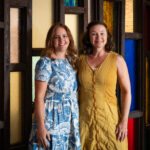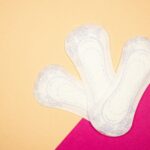By Jasmine Jones
On the day of the puberty talks in fifth grade, the teachers split us up: Boys went to the library, and girls stayed in the classroom. I remember being jealous the boys could be surrounded by books, all those distractions from the awkward video with monotone explanations of fallopian tubes our teachers pressed play on then promptly ignored as they pretended to be busy and we snickered amongst ourselves.
After the video, the teachers asked if we had any questions, and the girl who liked to make jokes raised her hand. “What about tampons?” she asked, boldly. Red flushed the faces of my classmates. About half of them laughed, but I wasn’t sure if the girl meant for this to be a joke or if it was a real question. “What about tampons?” Yes, I thought, what about them made us giggle and turn red?
Maybe it is because I remember girls comparing tampons to sex — another subject that made my classmates blush — and they acted as though they were one in the same thing. Using a tampon, having sex: Both were reserved for women. As fifth graders, we were comfortable in our childhood; we liked being called “girls.” We liked playing Barbie games online and pretending to be mermaids in the pool.
In middle school, this changed. It’s like we all woke up one Thursday morning and collectively looked in the mirror and screamed at our reflections, suddenly noticing everything “wrong” with our faces and bodies and deciding we needed to do something about it; we needed to be women, not girls.
I remember girls — myself included — stuffing their bras and applying makeup in the bathrooms before school. My friend smuggled in tubes of pink lipstick — her parents had banned makeup because they said “she was too young,” so she’d wipe it off of her face before her mother picked her up from school. I began to wake up at 5 a.m. to apply a full face of makeup and manically researched the stages of breast development, inspecting diagrams weekly to figure out how much longer it’d take before I looked like a “real woman.”
It was this secret of mine. To still be a girl in middle school, junior high and early high school, when everyone else was talking about their periods and I’d nod along as if I knew anything about the feeling of blood slipping from my body, staining my favorite pair of jeans. I wanted a magical microwave oven that I could put my plank-straight body inside, set the timer for one minute, and come out with widened hips, breasts and a regular menstrual cycle.
But unfortunately, magical puberty microwaves do not exist; I’d have to wait a little longer before I got my period. When it finally happened during my junior year of high school — a long-awaited and joyous occasion — I started using pads and prayed I wouldn’t get my period during a dance competition or beach vacation. Tampons terrified me. I had read too many online forums about Toxic Shock Syndrome (TSS), and our health teacher had breezed through the menstrual cycle, instead, showing us the “Supersize Me” documentary where a man consumes McDonald’s for an entire month; I never learned in a classroom how rare TSS was or how to prevent it from occurring.
Mostly, I was deeply afraid of my body, paralyzed by visions of tampons disappearing inside of me, coiled up inside my uterus like a stray cheese puff under a couch cushion. Tampons were foreign objects with plastic applicators and strings; they required at least some knowledge of one’s own anatomy, and I felt as though I was becoming a woman with no user’s manual. Blood came from somewhere inside of me, I thought at the time. It may as well have been the result of a field of red flowers decaying monthly in my stomach — that’s how mysterious it all felt.
So, I used pads and never felt the pressure to switch to tampons until my senior year of high school when one of the acquaintances I sat with at lunch started her period early and asked in a loud whisper: “Does anyone have a tampon?” We shook our heads, and I pulled out a pad, tucked it between my thumb and index finger like a secret dollar bill that I passed to her under the table. “Here,” I said. (For some reason, I felt and feel the need to hide pads and tampons, even today, because to do the opposite would be like shouting: “Currently, I am bleeding! Yes, blood! And lots of it.” And I certainly couldn’t draw attention to something I’d been taught to be quiet about.)
When I slipped the pad to my lunch friend, she wouldn’t take it. Her face contorted as if she just got a big whiff of the cafeteria trash can. “Gross,” she said. “I don’t use pads. I don’t want to sit in blood.”
In that moment, I sat there, shocked that tampons, once considered shameful in late elementary school, were now the socially-approved way of regulating one’s menstrual cycle. What I gathered from her comment: Pads were the equivalent of diapers, something babies used, not women, not us high schoolers with colleges rapping at the door and pressures to date and marry steadily rising.
This comment stuck with me and expedited what I’ll call the “tampons trials:” countless fearful attempts to insert a tampon every time I got my period, then failing to insert said tampon, feeling bad about failing, and then spending hours on the internet researching tampon insertion methods, vowing to succeed the next month. By the time I inserted a tampon correctly for the first time at 19 years old, I realized how silly it was to stress over and attempt to change my personal preference for period products.
Because who, if anyone, decided this “normal” timeline for us, dictating the right way to move from girl to woman and how to experience both, how to experience everything from a changing body and menstruation to a first kiss, and more importantly, why did I listen so closely to this unidentified, unsourced voice during my youth?
I worried about womanhood, listened to the voice and wasted precious hours of my girlhood. When really, this timeline, this voice, does not exist. Just as everyone’s life takes an unique and individual course, so do our bodies. There is no right or wrong way to experience womanhood. And when it comes to pads and tampons, if we strip down the preconceptions, the rumors, the stigmas, they’re just hygiene products. Plain and simple. Like a brand of toothpaste or face wash: Use what works for you, and don’t overthink it.
This reminds me of the village of paper dolls I kept under my bed in middle school. Yes, I was so ashamed of my joyful play that I felt the need to hide it. And not only hide it, but keep it under the place I slept, where I put my growing girlish limbs to rest each night. Oh, how I wish I could go back to that girl, as a woman, and tell her: “Girlhood is nothing to be ashamed of. And neither is womanhood.” I would shake her by the shoulders gently and say, “Don’t ever rush this joy.”
Maybe I would add, “And when the time comes, don’t hide a tampon or pad in your palm. Let the world see it.” Because honestly, what a shame it is to hide such a miracle.


